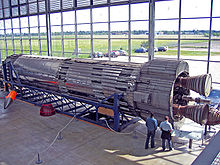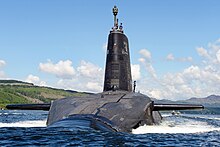









In 1952, the United Kingdom was the third country to develop and test nuclear weapons, after the United States and Soviet Union. [1] and is one of the five nuclear-weapon states under the Treaty on the Non-Proliferation of Nuclear Weapons. [2]
Contents
- 1913
- 1932
- 1933
- 1938
- 1939
- 1940
- 1941
- 1943
- 1944
- 1945
- 1946
- 1947
- 1948
- 1949
- 1950
- 1951
- 1952
- 1953
- 1954
- 1956
- 1957
- 1958
- 1959
- 1960
- 1961
- 1962
- 1963
- 1965
- 1967
- 1968
- 1973
- 1979
- 1981
- 1982
- 1984
- 1988
- 1991
- 1992
- 1996
- 1998
- 2006
- 2016
- Notes
- References
The UK initiated a nuclear weapons programme, codenamed Tube Alloys, during the Second World War. [3] At the Quebec Conference in August 1943, it was merged with the American Manhattan Project. [4] The British contribution to the Manhattan Project saw British scientists participate in most of its work. [5] The British government considered nuclear weapons to be a joint discovery, [6] but the American Atomic Energy Act of 1946 (McMahon Act) restricted other countries, including the UK, from access to information about nuclear weapons. [7] Fearing the loss of Britain's great power status, the UK resumed its own project, [8] now codenamed High Explosive Research. [9] On 3 October 1952, it detonated an atomic bomb in the Monte Bello Islands in Australia in Operation Hurricane. [10] Eleven more British nuclear weapons tests in Australia were carried out over the following decade, including seven British nuclear tests at Maralinga in 1956 and 1957. [11]
The British hydrogen bomb programme demonstrated Britain's ability to produce thermonuclear weapons in the Operation Grapple nuclear tests in the Pacific, [12] and led to the amendment of the McMahon Act. [13] Since the 1958 US–UK Mutual Defence Agreement, the US and the UK have cooperated extensively on nuclear security matters. The nuclear Special Relationship between the two countries has involved the exchange of classified scientific data and fissile materials such as uranium-235 and plutonium. [14] [15] After the cancellation of the Blue Streak in 1960, [16] the US supplied the UK with Polaris missiles and nuclear submarine technology. [17] [18] The US also supplied the Royal Air Force and British Army of the Rhine with nuclear weapons under Project E in the form of aerial bombs, missiles, depth charges and artillery shells until 1992. [19] [20] Nuclear-capable American aircraft have been based in the UK since 1949, [21] but the last US nuclear weapons were withdrawn in 2006. [22] In 1982, the Polaris Sales Agreement was amended to allow the UK to purchase Trident II missiles. [23] Since 1998, when the UK decommissioned its tactical WE.177 bombs, the Trident has been the only operational nuclear weapons system in British service. [24]